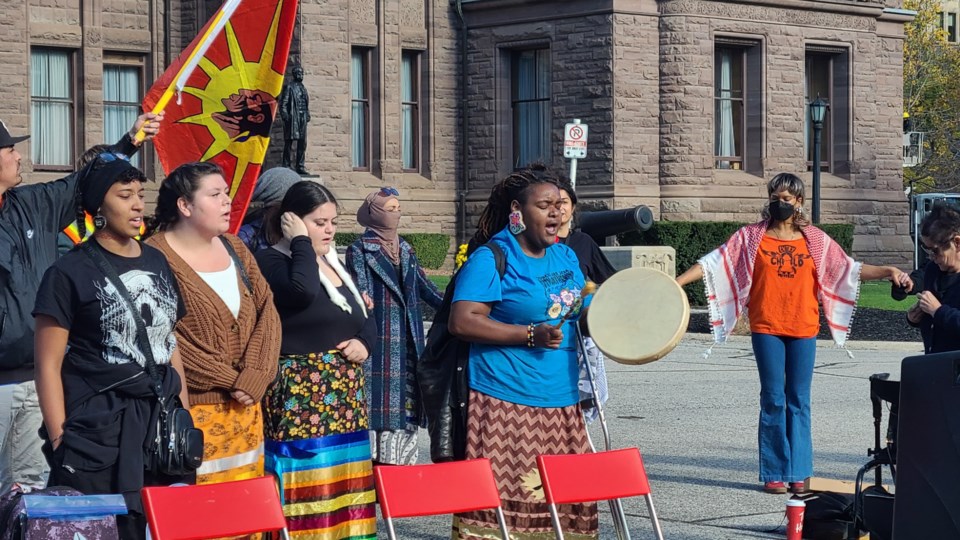Aamjiwnaang First Nation came to Queen's Park on Thursday to demand changes the Indigenous community says are necessary to address the "toxic pollution" and "environmental racism" it has faced for decades.
Aamjiwnaang's reserve is located just outside Sarnia in the so-called "Chemical Valley;" a heavily industrialized area that is home to more than 60 chemical facilities and refineries that have been built around the First Nation over time.
While community members and their supporters protested outside the legislature, Aamjiwnaang leaders inside told reporters that their territory has been used as an "environmental sacrifice zone," which has also come at the cost of the ability to lead healthy lives or engage in traditional activities guaranteed to them under Treaty No. 29.
"The environmental injustice that the people of Aamjiwnaang have been subject to is an ongoing tragedy and a stark example of environmental racism today," said band councillor Darren Henry, who said that there needs to be an overhaul of the relationship between the First Nation and province.
"We need a seat at the table, and our concerns must inform the path forward. We want to be part of the solution. We want to feel that the air we are breathing is not slowly killing us."
Aamjiwnaang Chief Janelle Nahmabin accused the Ontario government of ignoring years of calls from her community for changes to help protect them from the impact of pollution. She said the status quo can no longer hold, especially after the benzene leak at a facility owned by INEOS Styrolution last April which caused widespread headaches, nausea and dizziness at the nearby band office.
The leak led to a state of emergency declared by Aamjiwnaang, which also demanded that the plant be shut down following the leak. The province forced the facility to close temporarily until the source of the leak was found and fixed. The company attempted to appeal the closure at the Ontario Land Tribunal before deciding to permanently wind down operations because it would cost too much to reopen.
"Pollution control solutions are readily available and they are cost-effective. We have recommendations that would lower sulphur dioxide (SO2) (that are) the first step in addressing the cumulative impacts of our community," said the chief.
"There's no longer any excuse for Ontario government officials to continue to delay in implementing these solutions."
Specifically, Aamjiwnaang is asking the province to update regulations regarding the Lambton Industrial Meteorological Alert (LIMA), which currently requires all chemical plants in Chemical Valley to cut production if SO2 levels in the area reach 700 parts per billion.
Chemical engineering consultant Scott Grant noted to reporters those regulations are 40 years old, and out of step with current science. The allowable SO2 levels, he said, should be lowered to just 10 parts per billion.
"It's unconscionable that this regulation hasn't been updated," said Grant. "We've had conversations going back years, and yet they just sort of play the game of pass the buck, and nothing ever actually gets done."
During question period, NDP MPP Sol Mamakwa asked why the regulation had not been updated. Acting Environment Minister Todd McCarthy noted that the province did introduce a new regulation restricting benzene emissions after the leak this spring, and added two more benzene monitoring stations in the area.
"We recognize Aamjiwnaang First Nation’s long-standing concerns about the impacts of air pollution in their community and we share the same goal — the common cause — of a clean environment. That’s why our ministry continues to meet with that community on a regular basis to discuss these concerns and ensure they are addressed appropriately," said McCarthy.
The First Nation is also calling on the province to take action on the issues identified by the Ministry of Environment's Sarnia Environmental Health Project, which published its final report earlier this year.
Although the report highlights concerns about high S02 and benzene missions in the area, Grant told The Trillium that he still considers the report to be a "whitewash" that did not go far enough in its recommendations.
Aamjiwnaang also wants the province to begin technical reviews of possible pollution control measures, follow-up investigations on past contamination, and a review to "assess the need for improved oversight of industry process safety management practices."
After question period on Thursday, Minister McCarthy met with the delegation from Aamjiwnaang to hear their concerns and recommendations.
On his way there, he said that although the province has been taking action to address toxic emissions "there are more conversations to be had, and we're going to have them right now."
One participant in the meeting told The Trillium afterwards that McCarthy had not made any promises, instead saying he would work with the federal government on the situation and try to make changes to things that are within the sole control of the province.




